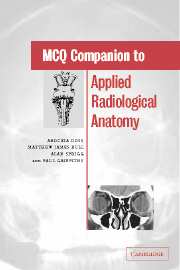The vertebral column
Published online by Cambridge University Press: 04 February 2010
Summary
Regarding imaging of the spine:
(a) The attenuation of fat is higher than that of cerebrospinal fluid on computerized tomography.
(b) Following administration of intravenous iodinated contrast medium, the spinal cord and nerve roots enhance.
(c) Bone and soft tissue is visualized using a window level of 40 HU and a width of 300 HU.
(d) CT myelography shows changes in spinal cord substance.
(e) On T2-W sequence CSF is of higher signal than neural structures and ligaments.
Concerning the vertebral column and the vertebra:
(a) Cervical lumbar lordoses are primary curves present at birth.
(b) The posterior column is formed by the posterior longitudinal ligament and the neural arch.
(c) The pedicles fuse laterally to form the spinous processes.
(d) Transverse process arises from the lateral aspect of the vertebral bodies.
(e) The pars interarticularis is the part of the lamina between the superior and inferior articular facets.
The vertebral column
ANSWERS
(a) False – CSF and water have an attenuation of about zero Hounsfield units – fat is radiolucent and has a lower attenuation of about – 60 to – 100 and appears darker than CSF.
(b) False – following contrast, the spinal cord, nerve roots and intervertebral discs do not enhance. The spinal meninges, dorsal root ganglia and blood vessels enhance.
(c) False – separate window settings are required to visualize bone and soft tissue as follows: Bone (level 200 HU and width of 1500 HU); Soft tissue (level 40 HU and width 300 HU).
(d) False – shows any alteration in contour. MRI shows changes in spinal cord substance.
(e) True – T2-W images have a myelographic effect.
- Type
- Chapter
- Information
- MCQ Companion to Applied Radiological Anatomy , pp. 174 - 185Publisher: Cambridge University PressPrint publication year: 2003



